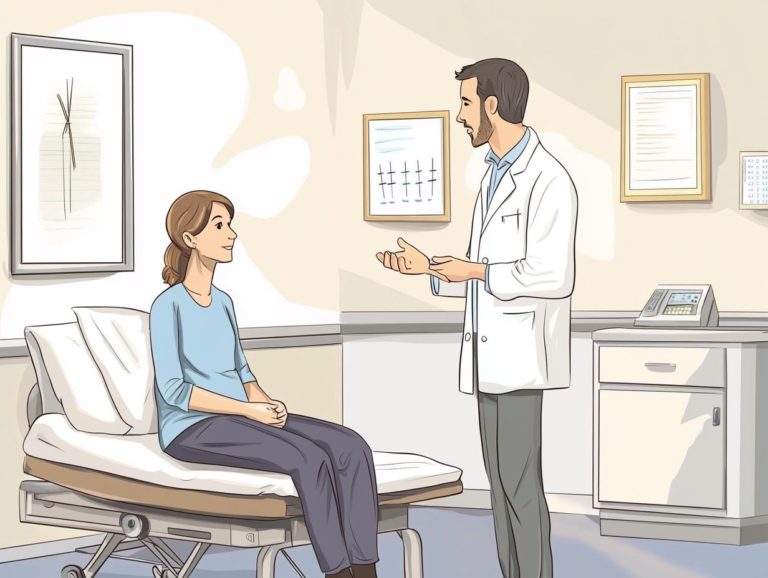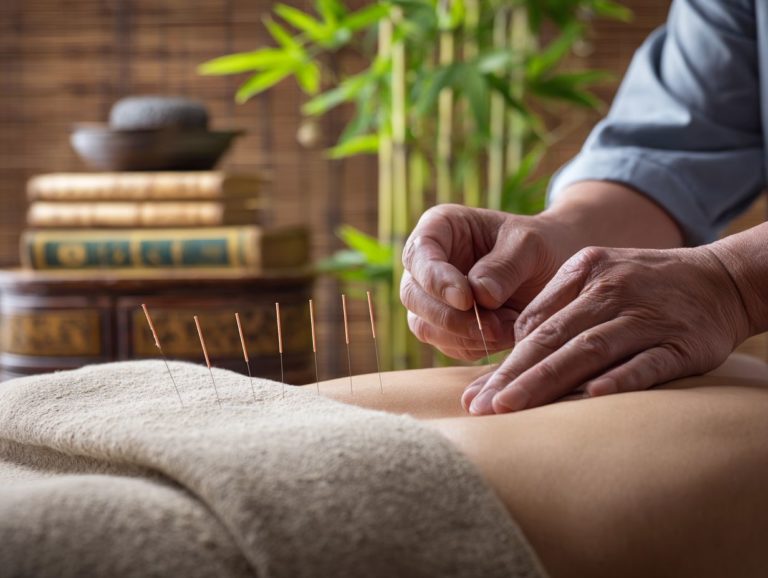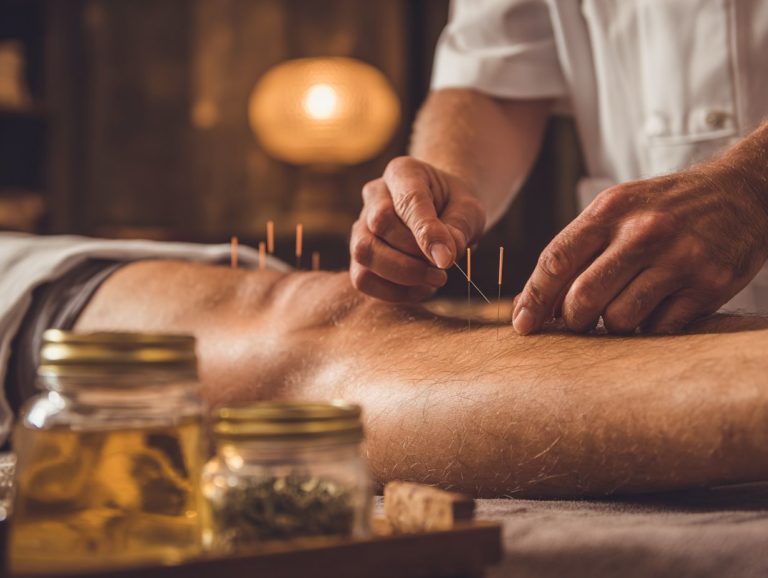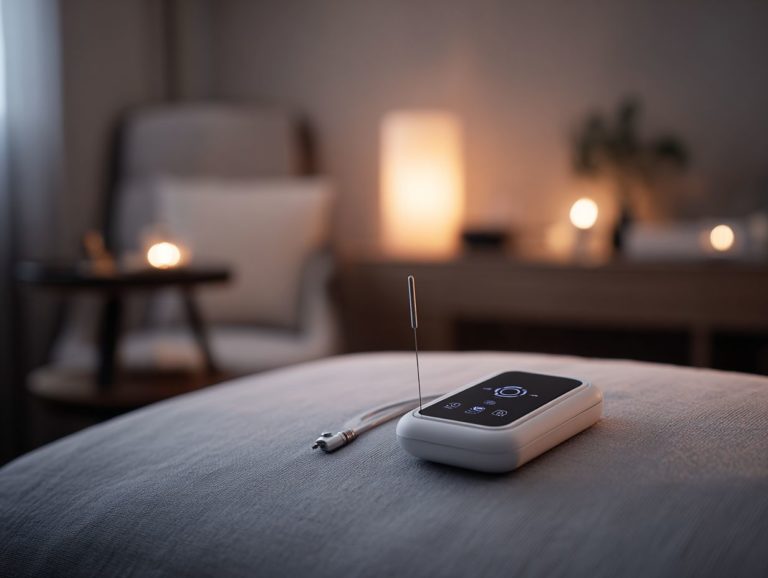Acupressure for Renal Colic: Techniques and Effectiveness
Struggling with renal colic can be excruciating, but acupressure offers a potential path to pain relief. This treatment method, based on acupuncture ideas, intends to reduce pain without depending only on standard painkillers. In this article, we’ll look at useful acupressure techniques, their effectiveness in handling kidney pain, and information from clinical studies. Learn how basic methods can improve your comfort and health during painful times.
Key Takeaways:
Contents
- 1 Understanding Acupressure
- 2 Acupressure Techniques for Renal Colic
- 3 Effectiveness of Acupressure for Renal Colic
- 4 Efficacy of Acupressure and Acupuncture for Acute Renal Colic
- 5 Safety and Contraindications
- 6 Integrating Acupressure with Other Treatments
- 7 Practical Tips for Self-Acupressure
- 8 Frequently Asked Questions
- 8.1 What is acupressure for renal colic?
- 8.2 How is acupressure different from acupuncture for renal colic?
- 8.3 What are the specific acupressure points used for treating renal colic?
- 8.4 Is acupressure for renal colic effective?
- 8.5 Are there any risks associated with using acupressure for renal colic?
- 8.6 Can I use acupressure for renal colic at home?
Definition and Causes
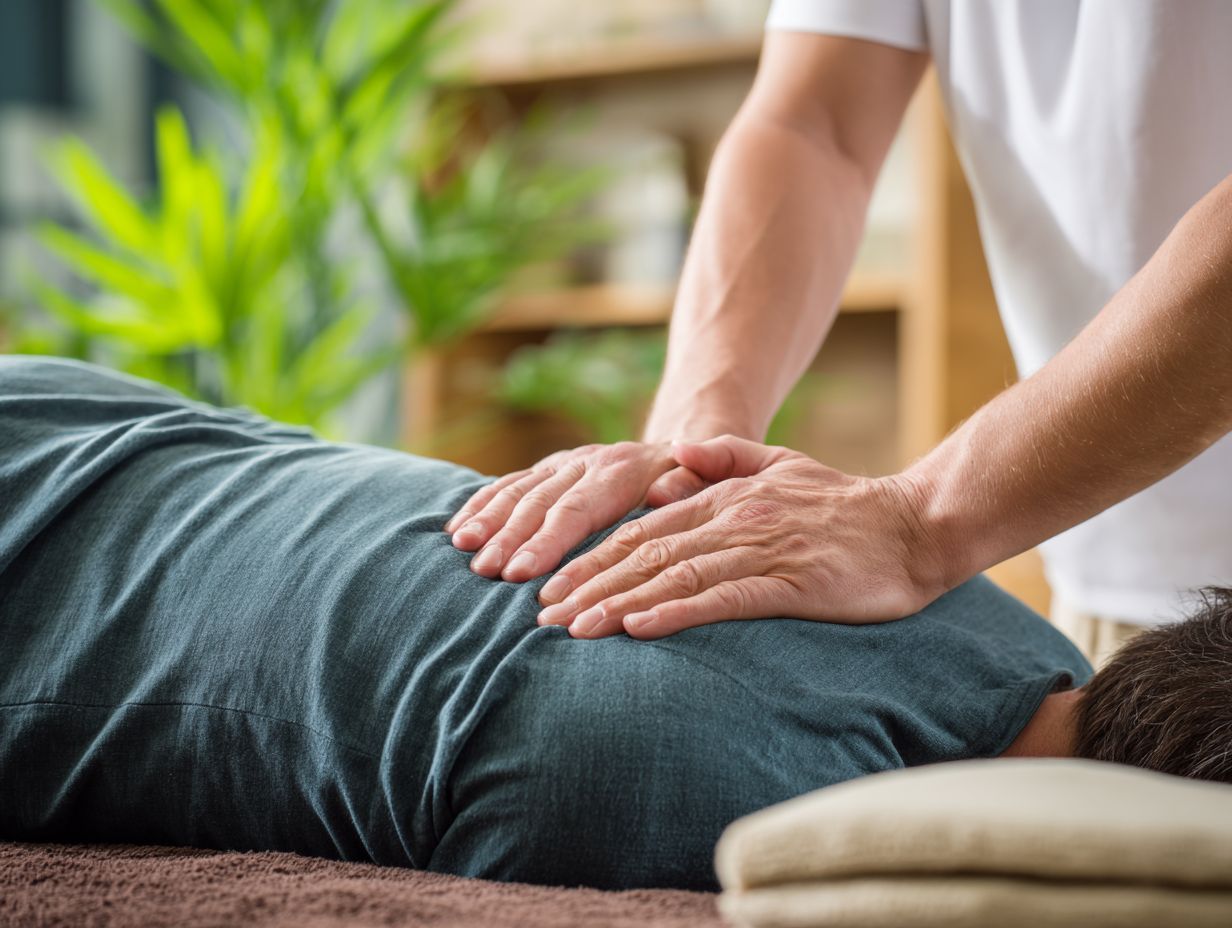
Renal colic is intense pain coming from the kidneys, usually caused by kidney stones, and can cause major discomfort and problems.
The main cause of renal colic is kidney stones, which can form as calcium oxalate, uric acid, or struvite stones. For additional insights, an overview by Mayo Clinic offers a comprehensive look at the symptoms and causes associated with kidney stones.
For instance, calcium oxalate stones can develop due to high dietary oxalate intake, while uric acid stones may form in those with dehydrated conditions. Not drinking enough water greatly increases the chance of developing kidney stones, so it is important to drink plenty of fluids.
Genetic predisposition can play a role; if kidney stones run in your family, your risk increases. Addressing these factors can help prevent renal colic episodes.
Symptoms and Diagnosis
Patients with renal colic typically present with intense flank pain, which can radiate to the abdomen and groin, commonly assessed using a visual analog scale.
In diagnosing renal colic, healthcare professionals often start with a thorough medical history and physical examination to identify additional symptoms like hematuria or nausea.
Imaging techniques are very important; for example, a non-contrast CT scan is very good at finding kidney stones and is often considered the best method. As detailed by Healthline, CT scans for kidney stones offer high accuracy in detection and are highly beneficial despite certain risks. Ultrasound is also efficient, especially in pregnant patients or those who require a radiation-free option.
Evaluating pain intensity using a numerical rating scale helps monitor the patient’s condition effectively throughout treatment.
Understanding Acupressure
Acupressure is a traditional Chinese medicine technique that uses hand pressure on certain spots to help the body heal itself and relieve pain, such as kidney stone pain. According to a detailed overview by Britannica, acupressure involves targeting specific pressure points that are believed to enhance health and relieve various pain symptoms. For those interested in exploring similar techniques, learn more about the effectiveness of acupuncture for pain relief which complements the principles of acupressure.
History and Principles
Originating from thousands of years of traditional Chinese medicine, acupressure is based on the belief that stimulating specific points can balance the body’s energy, or Qi.
Acupressure operates on the principle that energy flows through meridians in the body. Unlike acupuncture, which uses needles to stimulate these points, acupressure employs manual pressure from fingers, palms, or elbows.
To help with headaches, press the LI4 (Hegu) point located between the thumb and index finger for a few minutes. Practitioners might also use tools such as acupressure mats or balls to apply pressure more effectively and help with relaxation.
This hands-on approach makes it accessible for self-care, providing relief for various ailments without requiring professional supervision.
How Acupressure Works
Acupressure works by applying physical pressure to specific points, facilitating blood flow, reducing muscle tension, and enhancing the body’s natural pain relief mechanisms.
This technique stimulates the release of neurochemicals like endorphins and serotonin, which can diminish the perception of pain.
For instance, pressing the LI4 point, located between the thumb and index finger, can alleviate headaches, while the PC6 point, found on the inner forearm, is effective for nausea.
By incorporating acupressure into a regular wellness routine, individuals can actively engage in their own pain management, often requiring only a few minutes per session to notice beneficial effects.
Using acupressure with deep breathing can increase relaxation and help relieve pain.
Acupressure Techniques for Renal Colic
Various acupressure techniques can help ease pain from kidney stones, providing relief for patients during intense episodes. For those interested in complementary treatments, exploring how to manage pain with acupuncture can further enhance relief strategies.
Key Acupressure Points
Key acupressure points such as LI4 (Hegu) and SP6 (Sanyinjiao) are critically effective in managing pain associated with renal colic.
LI4, located between the thumb and index finger, can be stimulated by pressing firmly for 30 seconds to a minute. This point alleviates general pain and discomfort.
SP6 is found on the inside of the leg, about four finger widths above the ankle bone. Stimulating this point, also for 30 seconds, helps alleviate tension in the lower abdomen and supports kidney function.
Regular application of these techniques can significantly reduce pain episodes, providing a natural approach to managing discomfort from renal colic.
Technique 1: Applying Pressure on Specific Points
Applying sustained pressure on specific acupressure points can provide immediate pain relief for individuals experiencing renal colic symptoms.
To effectively relieve pain, focus on these key acupressure points:
- The Kidney 3 (located on the inside of the ankle), which alleviates kidney-related issues.
- The Bladder 23 (on the lower back, near the spine), known for its soothing qualities.
Press on these points with your thumb for 30 seconds to one minute, maintaining firm yet comfortable pressure. Repeat every few hours as needed.
Breathing slowly and deeply during this process helps you calm down and may lessen discomfort. Always talk to a healthcare professional if symptoms do not go away.
Technique 2: Using Circular Motions
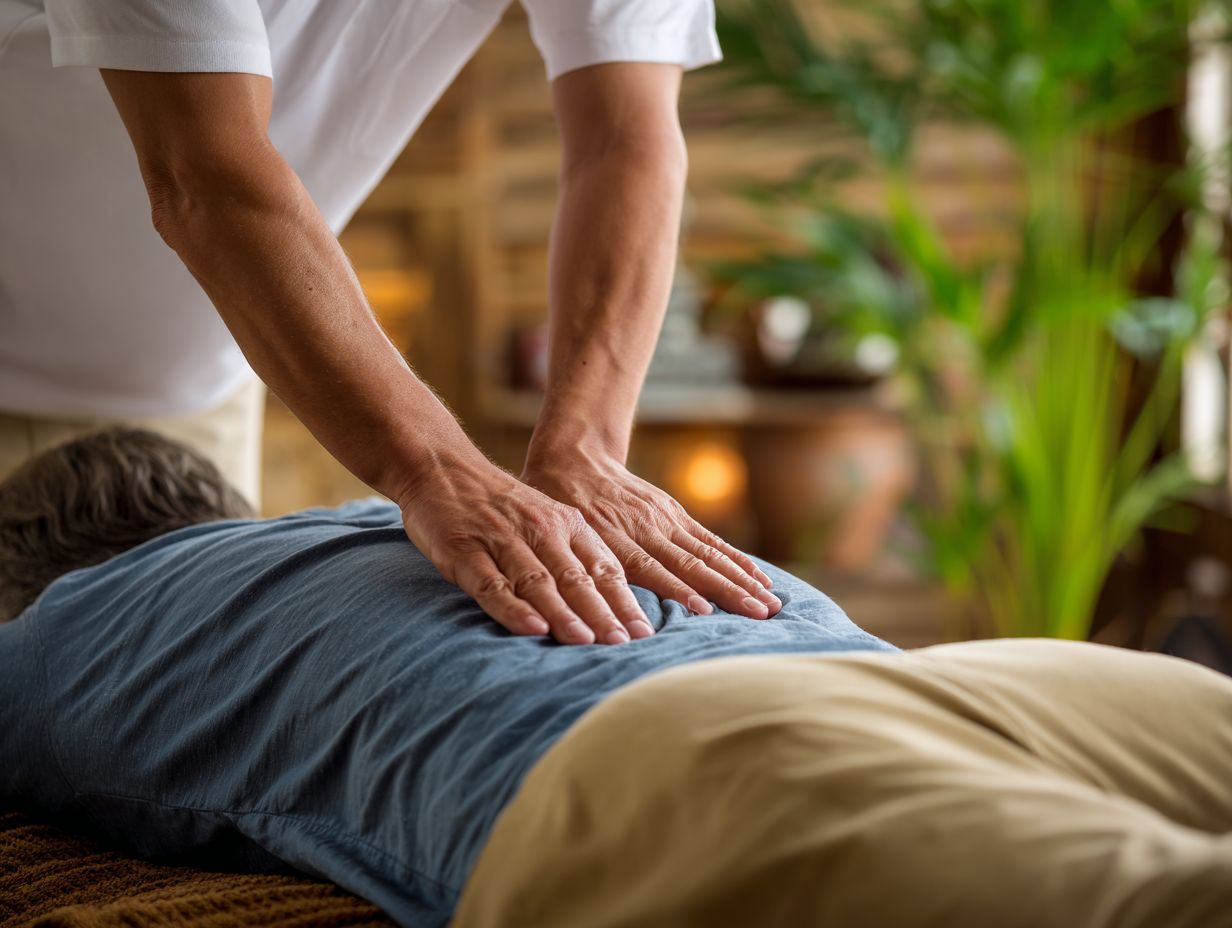
Gently rubbing acupressure points in circles can improve the benefits of the treatment, helping with relaxation and relieving pain.
To effectively apply circular motions, choose specific acupressure points such as the Feng Chi (GB20) at the base of your skull or the Neiguan (PC6) on your wrist.
Use your fingertips to apply gentle pressure, then perform small, circular motions for about 30 seconds on each point. Try to do this two to three times a day, especially when you’re feeling stressed or uncomfortable.
Using this method along with deep breathing can increase relaxation, allowing you to get the most out of it.
Technique 3: Combining with Breathing Exercises
Using acupressure along with deep breathing can greatly increase the body’s ability to relax and improve pain relief for kidney stone patients.
To effectively integrate these techniques, start by applying pressure on specific acupressure points, such as the ‘Kidney’ point (located on the inner ankle) while inhaling deeply for a count of four.
Hold that breath for another count of four, then exhale slowly for six counts, releasing the pressure point to coincide with your out-breath. Repeat this cycle for 5-10 minutes.
This breathing pattern, combined with targeted pressure, helps achieve better relaxation, easing tension and pain linked to kidney stones.
Effectiveness of Acupressure for Renal Colic
Studies show that acupressure can effectively ease pain for people with kidney stones in different medical environments. Additionally, ear acupuncture techniques are known for their benefits in pain relief, offering alternative therapeutic options.
Efficacy of Acupressure and Acupuncture for Acute Renal Colic
Efficacy of Acupressure and Acupuncture for Acute Renal Colic
Pain Reduction and Treatment Outcomes: VAS Score Reduction
Pain Reduction and Treatment Outcomes: Comparative Analysis
Pain Reduction and Treatment Outcomes: Acupuncture vs. Sham Acupuncture
The study on the Efficacy of Acupressure and Acupuncture for Acute Renal Colic offers a detailed examination of how these alternative therapies can help lessen pain and produce better results. The data focuses on the effectiveness of acupressure and acupuncture, employing metrics such as Visual Analogue Scale (VAS) score reduction and comparative treatment efficacy.
Pain Reduction and Treatment Outcomes show key information about how acupressure helps with pain management. The VAS score reduction for the acupressure group shows a significant initial impact, with pain reducing by 43.3% after just 1 minute. This effect tapers over time, with reductions of 26.5% after 5 minutes and 16.3% after 10 minutes. This rapid decrease in perceived pain suggests that acupressure can offer immediate, though short-term, relief for acute renal colic.
- The comparative analysis indicates a rapid onset time for achieving a 50% VAS score decrease in just 1.15 minutes. This fast response highlights acupressure’s ability to work quickly.
- The markedly effective rate, defined as a 60% reduction in VAS score, stands at 86.9%. This high effectiveness rate suggests that for a significant portion of patients, acupressure may provide considerable pain relief.
In the exploration of Acupuncture vs. Sham Acupuncture, the data reveals that the response rate for the acupuncture group is 70% compared to 40% for the sham acupuncture group. This 30% difference shows that acupuncture works better than a placebo, proving it to be a real treatment option for acute renal colic.
Overall, this dataset gives strong evidence showing that acupressure and acupuncture can effectively help manage acute kidney stone pain. These treatments quickly lessen pain and work well, offering patients fast and effective ways to manage pain.
Clinical Studies and Evidence
Recent randomized controlled trials (RCTs) demonstrate promising results for acupressure in alleviating renal colic pain, with effect sizes indicating significant clinical efficacy.
Studies have shown that acupressure applied at specific points, such as the ‘Liao points’ around the lower back, can lead to a reduction in pain scores by up to 30%. A meta-analysis of seven RCTs revealed that patients reported improved comfort levels and reduced need for additional pain medication following acupressure treatment.
To implement acupressure effectively, practitioners recommend applying firm pressure for 1 to 3 minutes on the designated points during acute episodes, potentially enhancing patient outcomes without reliance on pharmacological treatments.
Patient Testimonials and Case Studies
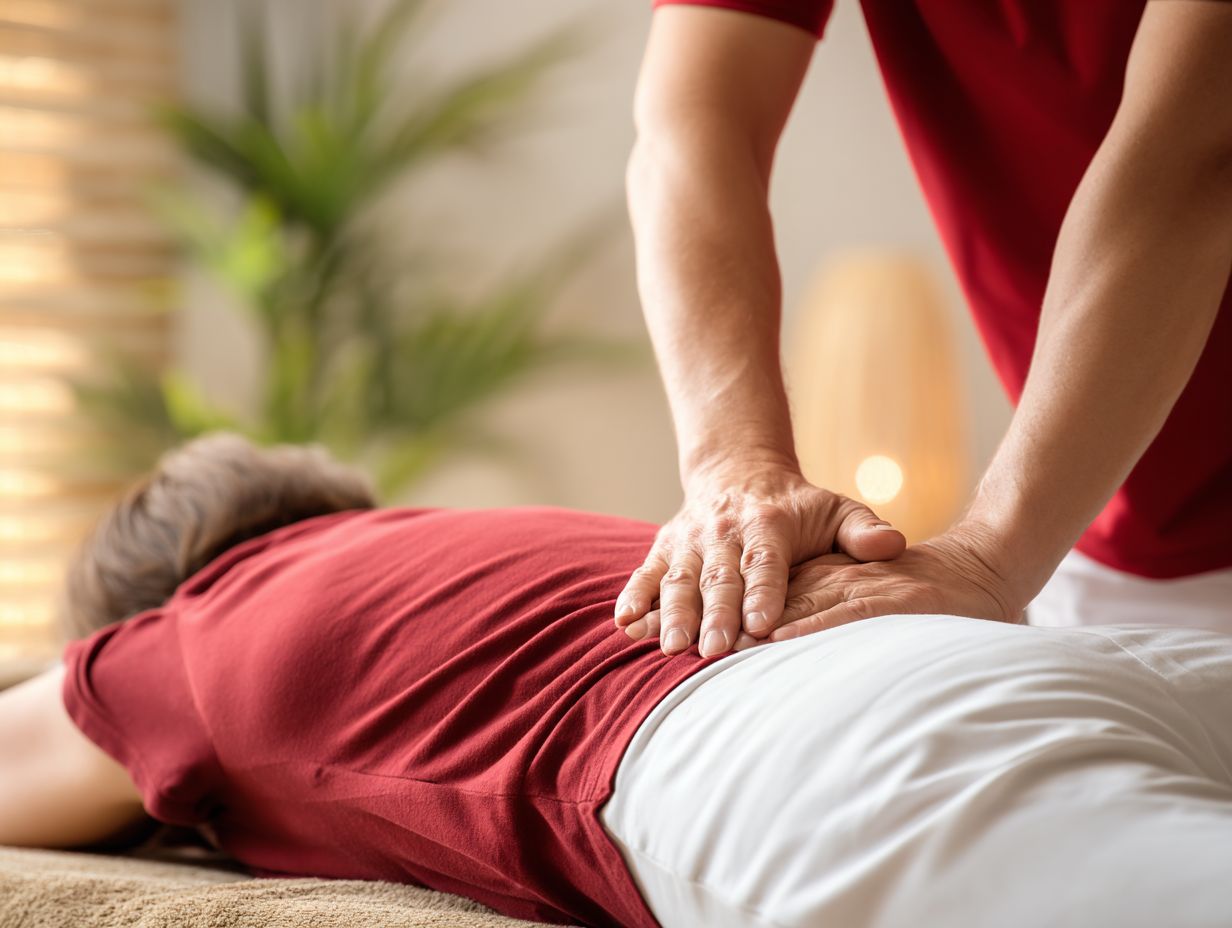
Patient testimonials reveal a positive trend in pain management experiences following acupressure treatment for renal colic, showcasing its potential as an analgesic alternative.
One patient, Sarah, reported significant relief within 30 minutes of applying pressure to specific points on her wrist and foot, which she learned from an acupressure guide app.
Another user, Mark, used a detailed acupressure video series that taught techniques and highlighted the importance of breathing exercises.
Both noted improved overall satisfaction with their pain management, claiming that acupressure helped them reduce reliance on medications.
By using these methods, patients could experience a complete approach to managing kidney pain.
Safety and Contraindications
Though acupressure is usually safe, there are specific situations where it should be avoided to prevent negative reactions in patients with kidney stones.
When to Avoid Acupressure
Avoid using acupressure for individuals experiencing sudden intense abdominal pain or having significant kidney issues.
Individuals with bleeding disorders, such as hemophilia, should refrain from acupressure, as it may exacerbate their condition.
Pregnant women are also advised against using acupressure on specific acupoints that may trigger contractions.
Anyone thinking about trying acupressure should talk to their healthcare providers first to make sure it is safe and works well, especially if they have existing health problems or are being treated for long-term illnesses.
Potential Side Effects
Though rare, potential side effects of acupressure can include transient soreness and, in some cases, exacerbation of pain if applied incorrectly.
To minimize risks, it’s essential to practice proper techniques. Start with gentle pressure, then slowly increase it as your body gets used to it.
Identify and avoid sensitive areas, particularly in individuals with chronic pain or recent injuries. Use acupressure mats on a firm surface, and talk to a healthcare professional if you have any health issues.
Document your experiences to track any adverse reactions, adjusting pressure or technique accordingly. This careful method can improve the advantages of acupressure while protecting your health.
Integrating Acupressure with Other Treatments
Combining acupressure with standard treatments can improve pain management for patients with renal colic, as mentioned in our detailed examination of acupuncture techniques for rib fractures.
Complementary Therapies
Combining treatments like NSAIDs and opioids with acupressure can improve pain relief for kidney stone pain.
Acupressure can improve the results of standard treatments by focusing on certain pressure points. For instance, applying pressure to the LI4 point, located between the thumb and index finger, can help alleviate abdominal pain.
Time matters; doing acupressure right before you take medicine might make it work better, while waiting around 30 minutes after taking medicine can prevent it from interfering with absorption.
Using acupressure for 5-10 minutes, two to three times daily, can help control ongoing pain effectively and reduce the need for stronger painkillers.
Consulting Healthcare Professionals
Talking to healthcare professionals makes sure that acupressure is correctly included in individual treatment plans for kidney stone pain.
Working with a doctor or acupuncturist helps patients learn acupressure methods in a safe and efficient manner.
For instance, targeting specific acupoints like the bladder (BL28) or kidneys (KI3) can help alleviate pain. It is important to talk about how often and how long sessions last, along with any other treatments being followed, to prevent possible interactions.
Think about trying apps like `Acupressure & Acupuncture’ to help you treat yourself. But remember to discuss with a specialist to make changes that suit your personal requirements and to stay safe, particularly if you have health issues.
Practical Tips for Self-Acupressure
Practicing self-acupressure allows patients to take active steps in managing kidney stone pain comfortably and easily.
How to Locate Acupressure Points
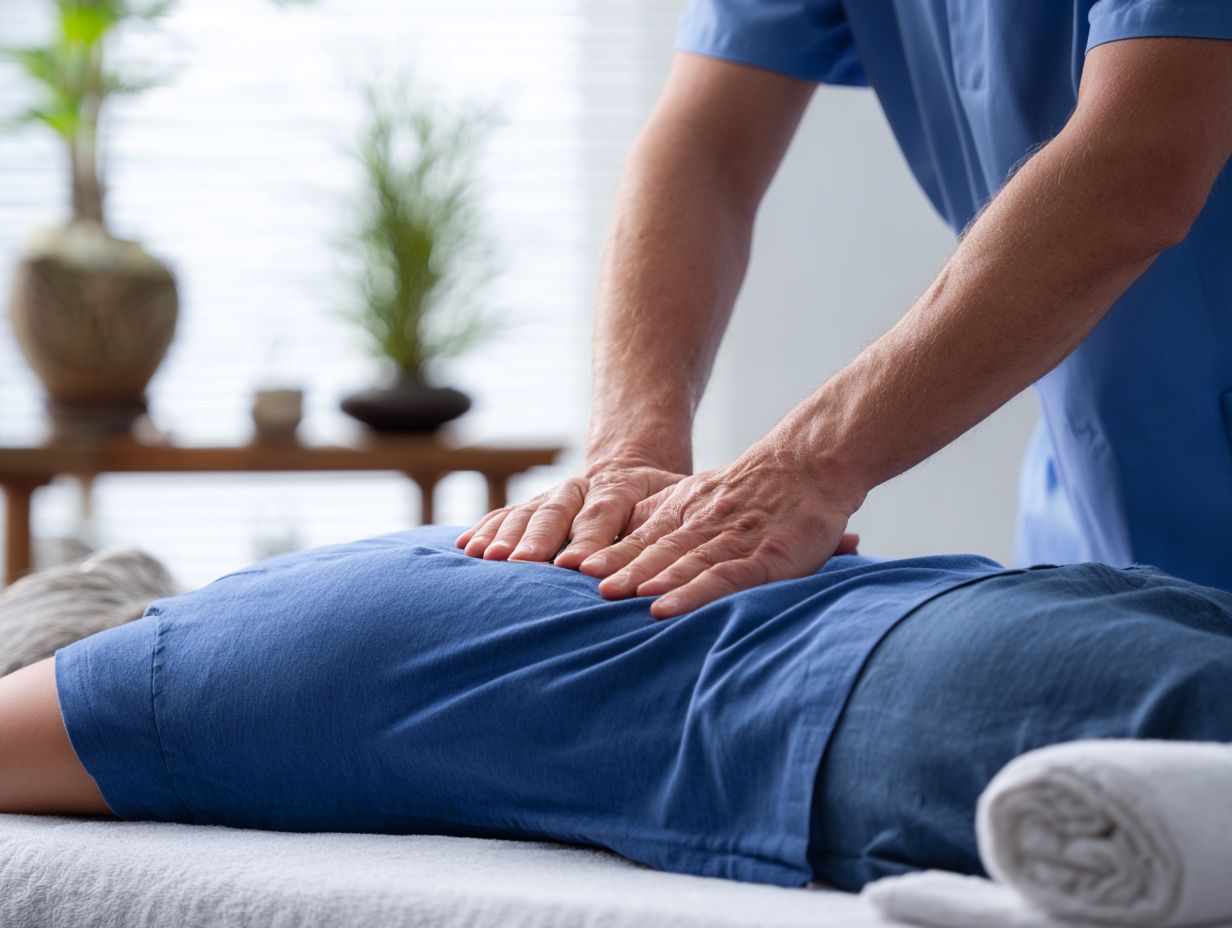
Locating acupressure points can be easily achieved using anatomical landmarks or visual guides, enhancing the effectiveness of self-treatment for renal colic.
Start by identifying the acupressure point called Zusanli (ST36), located about four fingerbreadths below the kneecap and one fingerbreadth outward from the shinbone.
Press down hard for 30 seconds and breathe deeply. Use diagrams available online or in acupressure books to visualize these points clearly.
Apps like ‘Acupressure: Heal Yourself’ can also guide you through self-treatment methods. Practicing regularly can significantly alleviate discomfort associated with renal colic.
Frequency and Duration of Sessions
To get the best results, patients should have acupressure sessions lasting 5-10 minutes multiple times a day, changing how often they do this based on their pain levels.
It’s essential to listen to your body; if you find that a particular technique offers significant relief, you may choose to increase the duration or frequency. Start with morning and evening sessions, then assess how your pain responds during the day.
Using tools like acupressure mats or balls can improve your routine by focusing on certain areas. To manage chronic pain, it’s important to follow a regular schedule. Use phone alerts to help stick to your routine, which can slowly improve pain control.
Summary of Benefits
The benefits of acupressure for renal colic include reduced pain scores, fewer analgesic-related complications, and improved patient satisfaction.
Using acupressure can help patients manage their own pain. Techniques such as applying pressure to the SP6 point-just above the ankle-can help alleviate discomfort.
Applying consistent pressure with a stress ball on certain spots can improve results. Patients often report using acupressure as a complement to traditional treatments, which may lead to decreased reliance on medications, benefiting overall health.
Encouraging patients to try this method can support a complete approach to managing kidney pain.
Frequently Asked Questions
What is acupressure for renal colic?
Acupressure for renal colic is a technique used in traditional Chinese medicine to relieve the pain and discomfort associated with renal colic. It involves applying pressure to specific points on the body to stimulate the flow of energy and promote healing.
How is acupressure different from acupuncture for renal colic?
Acupressure and acupuncture both use the same points on the body, but they differ in the method of stimulation. Acupressure uses pressure applied with the fingers or hands, while acupuncture uses fine needles to stimulate these points.
What are the specific acupressure points used for treating renal colic?
The specific acupressure points used for treating renal colic include the lower back, abdomen, and feet. The most commonly used points are BL23, BL22, and KI3.
Is acupressure for renal colic effective?
Many people have reported relief from renal colic pain and discomfort after using acupressure. However, acupressure may work differently for each individual. It is always recommended to consult a qualified acupressure practitioner for proper treatment.
Are there any risks associated with using acupressure for renal colic?
Acupressure is generally considered a safe practice when performed by a trained practitioner. However, there could be risks like bruising or soreness at the pressure points.
Can I use acupressure for renal colic at home?
Yes, you can perform acupressure at home, but it is important to consult a qualified practitioner first to learn the correct techniques and pressure points. It is also important to note that acupressure should not be used as a substitute for medical treatment and should only be used as a complementary therapy.

Sheetal Sharda has a background in CS. She got an interest in Holistic living back in 2018, and has since started exploring more into Naturapathy, Holistic Living, Yoga, and more. She got inspired to start SereneClinics to help people find reliable centers across the world.

